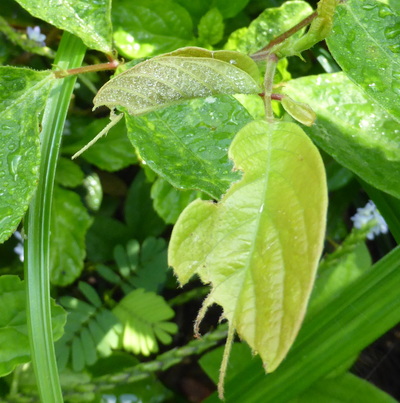Hesperiidae : Eudaminae
Cecropterus dorantes (Lucas, 1857)
Dorantes Longtail
Cecropterus dorantes (Lucas, 1857)
Dorantes Longtail
Previously known as: Urbanus dorantes.
Description and Similar Species: Wingspan 44-51mm. Both sexes have brown uppersides with a V-shape of white dots on the forewing and a chequered fringe. Males have slightly darker forewings. Underside is brown with a purplish tinge and darker transverse bands. Flies low to the ground. This one of three species of long-tailed skippers found in Cuba. Lacks the blue pruinescence on the upperside of Common Long-tailed Skipper Urbanus proteus. The Cuban Longtail Chioides marmorosa has more chestnut upperwings and a boldly patterned underside that shows pinky-purple on the hindwing. Continuously brooded and seen in all months from December to August and possibly others.
Range: Southern USA and Florida to Argentina.
Status: Common throughout Cuba.
Nectar Plants: Stachytarpheta jamaicensis, Ageratum conyzoides, Tournefortia hirsutissima, Walteria americana, Lippia alba, Tabernaemontana amblyocarpa, Lantana camara, Bidens pilosa, Wedelia rugosa and others. Also feeds on dung.
Larval Foodplants: Beans such as Phaseolus and Desmodium in the family Leguminosae.
Description and Similar Species: Wingspan 44-51mm. Both sexes have brown uppersides with a V-shape of white dots on the forewing and a chequered fringe. Males have slightly darker forewings. Underside is brown with a purplish tinge and darker transverse bands. Flies low to the ground. This one of three species of long-tailed skippers found in Cuba. Lacks the blue pruinescence on the upperside of Common Long-tailed Skipper Urbanus proteus. The Cuban Longtail Chioides marmorosa has more chestnut upperwings and a boldly patterned underside that shows pinky-purple on the hindwing. Continuously brooded and seen in all months from December to August and possibly others.
Range: Southern USA and Florida to Argentina.
Status: Common throughout Cuba.
Nectar Plants: Stachytarpheta jamaicensis, Ageratum conyzoides, Tournefortia hirsutissima, Walteria americana, Lippia alba, Tabernaemontana amblyocarpa, Lantana camara, Bidens pilosa, Wedelia rugosa and others. Also feeds on dung.
Larval Foodplants: Beans such as Phaseolus and Desmodium in the family Leguminosae.
Egg
Larva














